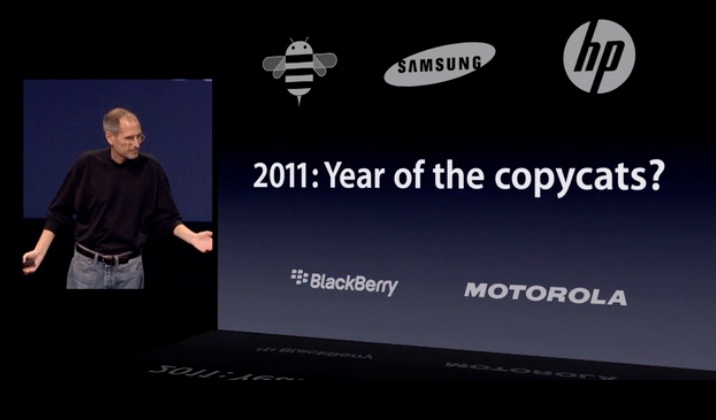Don’t you understand? Samsung ‘flattery’ killed product design

Think back a few years to when Samsung made some pretty flattering ‘versions’ of Apple’s iPhone and iPad product lines. Apple got annoyed enough to call them “slavish imitations”, Apple fans sided with the company and the Phandroid army (and friends) yelled that Samsung had done nothing wrong. Apple turned to the courts.
And still that story goes on.
Right now Apple is arguing that Samsung should pay it millions in damages, even though Samsung continues to say it shouldn’t. “Apple Inc deserved the hundreds of millions of dollars in damages Samsung Electronics Co Ltd paid for infringing patented designs of the iPhone because the product’s distinctive look drives people to purchase it,” Reuters states.
Naturally Google (who every music business veteran knows is a great champion of copyright) and some other tech firms are siding with Samsung. Probably because they don’t really make any hardware.
Who is siding with Apple?
Designers. Over 100 of them. Designers including Calvin Klein, Paul Smith, Alexander Wang, the industrial design director at Parsons School of Design, the design director for Bentley Motors, and Tony Chambers, the editor-in-chief of Wallpaper magazine.
Designers including Norman Foster.
Dieter Rams! Sir Terance Conran…
These are not trivial names. This is not trivial deposition. Take a look at it.
So why are they supporting Apple?
Because they know that if Samsung is not forced to pay damages then there will be no point in designing anything. You can say goodbye to beautiful things, because once anyone creates them some upstart like Samsung will be able to copy them and the original designer will have no way to make things right.
The designers say the “look of the product comes to represent the underlying features, functions, and total user experience.” They say that if you make something that looks the same, and then in your marketing say it is more or less the same, consumers may choose the imitation.
Now we all know things are different in some countries in which different laws apply. But even in those countries Apple has good market positions based on its excellent software and hardware designs. Even in China iPhones are in great demand — if they can afford it, people want the authentic Apples.
But if you think about it for more than a nanosecond you’ll realise that if design is not protected then you can say goodbye to lovely product designs forever. Because what will be the point?
Why would anyone put energy into making things look unique any more? Why bother?
What’s the point?
You may think that’s fine. You may want to live in some grey, boring world in which everything looks the same and nothing quite does what it claims. Where everything is ordinary and nothing really works. Where the products you get to choose are big on promise and short on delivery.
I don’t.
Fingers crossed the designers will win.





Looking at this image that shows Samsung phones before and after the iPhone, it is easy to understand why Apple sued Samsung:
http://todayilearned.co.uk/wp-content/uploads/2012/07/samsung-phones-before-and-after-iphones.jpeg
In fact those copycat phones, and Google’s copycat multi-touch operating system (with the same user interface and multitouch gestures as iOS), both came out in 2010… Three years AFTER the first iPhone was introduced.
I’m surprised that Apple still must continue to fight to get the compensation that was awarded to them years ago for Samsung’s indisputable infringement of Apple’s intellectual property.
Me also.
But in this case the reason we don’t have nice things is (at least) not our fault.
I can still see the ignorati puggishly barking, “Yeah, Apple patented rounded corners, chamfered bezel, etc.” whenever this idea of design comes up. Look at the pre-iPhone Samsung phones: nary a rounded corner or chamfered bezel to be found. Samsung’s design ethic was boring, unimaginative, ugly, and unintuitive.
I would hate to see a world in which design was killed due to lack of protection or reward. Why I even remember an episode of Little House on the Prairie, where Charles designed a table that he wanted as his “legacy to be remembered by” that started selling well, so a furniture magnate bought one, copied it, manufactured it in his factory, and sold it for much less, running Charles out of business. Good ol’ unfettered Capitalism! (Episode 175, The Legacy, 1982)
I thought it was unfair then. I think it’s unfair now. Make Samsung pay!
I see it that way too